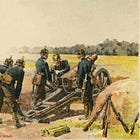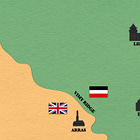Welcome to the Tactical Notebook, an evergreen publication that explores the armies that are, the armies that were, and the armies that might have been.
While reports about the actions of Israeli ground troops in the Gaza Strip abound, definitive information is hard to come by.1 That said, a careful sifting of these stories yields observations that, when viewed in the light of local terrain and previous Israeli operations in Gaza, reveal the broad outlines of the much anticipated Israeli ground campaign.
While Israeli bombs and missiles have fallen throughout the Gaza Strip, the lion’s share of such projectiles seem to have landed in the area that spokesmen for the Israeli Defense Forces have come to call Northern Gaza.2 Within Northern Gaza, moreover, the place most heavily punished seems to be the city of Beit Hanoun.
To borrow a phrase from the First World War, Northern Gaza forms a salient. That is, it adjoins Israeli territory on two sides, thereby offering opportunities for both flanking fires and flanking maneuvers. Within this larger bulge, Beit Hanoun forms a smaller, sharper, more salient salient. That is, while Israeli gunners could easily find positions from which to subject Northern Gaza to a two-way crossfire, they would be able to fire upon Beit Hanoun from three distinct directions.
Taken together, the pattern of bombardment and the geometry of Northern Gaza suggest the possibility that the Israeli ground forces plan to conduct (and, indeed, may already have begun) a sequence of attacks with limited objectives aimed at the conquest of the northern third of the Gaza Strip. Moreover, should it take place, this series of bite-and-hold enterprises will, in all likelihood, begin with an attempt to take possession of Beit Hanoun.
In addition to explaining the distribution of bombs and missiles, this thesis allows us to make sense of the repeated calls made by official spokesmen of the Israeli Defense Forces for the evacuation of all civilians from Northern Gaza. It also provides an explanation for a number of statements made by Israeli Prime Minister Benjamin Netanyahu since 7 October 2023, particularly that the conflict would be “a long and difficult war,” that it resembled the Israel’s War of Independence of 1948, and that it would only end with the destruction of Hamas.
In previous wars between Israel and Hamas, Israeli ground forces performed three tasks. First, they isolated the Gaza Strip. Second, they participated, with rockets, missiles, and gun-howitzers, in long-range bombardments. Third, they conducted coups de main in the style of the shallow and shocking trench raids of the First World War.
Such actions, however, served purposes other than the annihilation of Hamas. Indeed, while they used raids, blockades, and bombardments to punish offenses and discourage their repetition, Israeli leaders took care to avoid doing anything that might deprive Hamas of its rule over the people of Gaza. (They often explained such forbearance by expressing fear that any regime that replaced Hamas would, in all likelihood, prove more radical.)
Likewise, in contrast to the War of Independence, previous wars with Hamas involved neither the wholesale expulsion of people from their homes nor the seizure of land. The destruction of Hamas, moreover, will require both, if only to convince the people of Gaza that support for organizations of its type will result, not merely in loss of life, but also in the loss of the things they had spent lifetimes to build.
Finally, the prediction of “a long and difficult war” suggests the possibility of a plan to follow each bite-and-hold attack with a substantial period of relative inaction. Such pauses would allow Israeli ground forces to build up stocks of ammunition, refine techniques, invent new devices, and train units. It would also allow Israel as a whole to spread the costs of the campaign, whether human, economic, or diplomatic, over a long period of time.
For Further Reading:
While anachronistic and awkward, the use of the term Gaza Strip allows the reader to distinguish between that part of Palestine ruled by Hamas and the capital of that polity, Gaza City.
This article presumes that Northern Gaza encompasses that part of the Gaza Strip that lies north of the southern boundary of Gaza City. Some observers, however, align the southern boundary of Northern Gaza with the Wadi Gaza, an arroyo that runs along the south end of the open area south of Gaza City.









